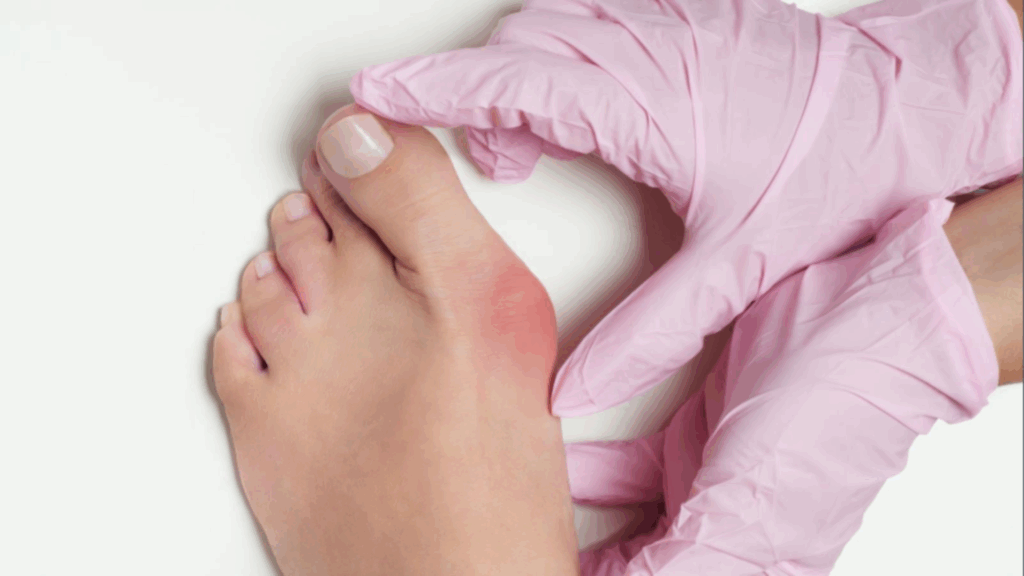Foot pain can significantly impact your daily life, and when multiple conditions affect your feet, the discomfort can be even greater. Two common deformities, bunions and hammer toes, often appear together, creating a complex challenge for patients. At Fall Creek Foot & Ankle, we frequently see cases where a bunion with hammer toe presents, and understanding their connection is crucial for effective treatment.
What is a Bunion?
A bunion is a bony bump that forms on the joint at the base of your big toe, where it connects to the foot. It develops when the big toe pushes against the next toe, forcing the joint to stick out. This condition, known as hallux valgus, can be caused by inherited foot type, ill-fitting shoes, or certain medical conditions. Symptoms include pain, redness, swelling, and difficulty wearing shoes. For more information visit our Bunion Treatment Blog.
What is a Hammer Toe?
A hammer toe is a deformity that causes your toe to bend or curl downward, rather than laying flat. While it can affect any toe, it most commonly impacts the second, third, or fourth toe. Hammer toes often result from an imbalance in the muscles, tendons, or ligaments that hold the toe straight, often exacerbated by tight shoes. Pain, corns, calluses, and difficulty walking are common symptoms. For a deeper look, explore our Top Treatments for Hammer Toe article.
The Connection: Why a Bunion with Hammer Toe Often Occurs
Bunions and hammer toes commonly appear together because they both result from improper foot alignment and abnormal mechanics. A bunion can cause the big toe to angle outward—toward the second toe—placing pressure on it, which can eventually lead to the development of a hammer toe. The presence of one condition can often contribute to the development or worsening of the other. For instance:
- Big Toe Displacement: When a bunion forces the big toe inward, it can push against and crowd the adjacent toes. This constant pressure can cause the smaller toes to buckle, leading to the characteristic bent shape of a hammer toe.
- Altered Foot Mechanics: Both bunions and hammer toes can alter the way you walk and distribute weight on your feet. This imbalance can put increased stress on other parts of the foot, potentially encouraging the development of additional deformities or exacerbating existing ones.
- Footwear Challenges: The type of shoes that aggravate a bunion (narrow toe boxes, high heels) are often the same shoes that contribute to hammer toes. Trying to accommodate a bunion hammer toe can be very difficult with standard footwear.
Recognizing a Hammer Toe with a Bunion
When you have both a hammer toe and a bunion, the symptoms can often be compounded. Here are some common symptoms to watch for:
1. Increased Pain and Stiffness in the Affected Toes and Forefoot
As the big toe deviates outward due to the bunion and the smaller toes bend due to hammer toes, you may notice persistent pain and stiffness, particularly when walking, standing, or wearing shoes.
2. More Frequent Corns and Calluses
The abnormal toe positioning from both bunions and hammer toes can cause friction where the bent toes rub against shoes. This constant pressure results in the formation of corns and calluses on the affected toes and the top of the foot, leading to additional discomfort and irritation. For expert advice on managing corns and finding relief, check out our Expert Advice for Corns on Feet blog.
3. Greater Difficulty Finding Comfortable Footwear
The combination of a bunion and hammer toe can significantly alter the shape of your foot, making it harder to find shoes that fit properly. The pressure on the forefoot can also make it challenging to wear shoes with a narrow toe box, such as high heels or tight footwear.
4. Reduced Mobility and Balance
As the structure of the foot changes with both a bunion and hammer toes, your ability to move freely and maintain balance may be impaired. The altered alignment of the toes can affect your gait, causing difficulty when walking, running, or standing for extended periods.
Effective Treatments at Fall Creek Foot & Ankle
At Fall Creek Foot & Ankle, our expert podiatrists are dedicated to providing personalized and effective care for complex foot conditions like a bunion with hammer toe. Treatment options vary depending on the severity of the deformities and your specific needs.
Conservative Treatments: For many patients, non-surgical approaches can provide significant relief:
- Proper Footwear: Wearing shoes with a wide, deep toe box to reduce pressure on the deformities.
- Orthotic Devices: Custom orthotics can help redistribute pressure and improve foot mechanics. Learn more by visiting our Custom Orthotics: The Key to Foot Comfort and Mobility page.
- Padding and Taping: Cushions and pads can protect corns and calluses, and taping can help straighten toes.
- Medications: Anti-inflammatory drugs can help manage pain and swelling.
- Physical Therapy: Exercises can strengthen foot muscles and improve flexibility.

Surgical Interventions: When conservative treatments are no longer effective, surgical correction may be recommended. Our surgeons are skilled in advanced techniques to:
- Realign the big toe and remove the bony prominence associated with the bunion.
- Straighten and release the contracted tissues in a hammer toe.
The goal of surgery is to relieve pain, restore function, and improve the overall appearance of your foot.
Don’t Let Combined Foot Conditions Hold You Back
If you’re experiencing pain or discomfort from what you suspect might be a bunion hammer toe or any other foot deformity, don’t wait for the condition to worsen. Early diagnosis and intervention are key to preventing further complications and finding relief.
Contact Fall Creek Foot & Ankle today to schedule a consultation. Let us help you get back on your feet, comfortably and confidently.
